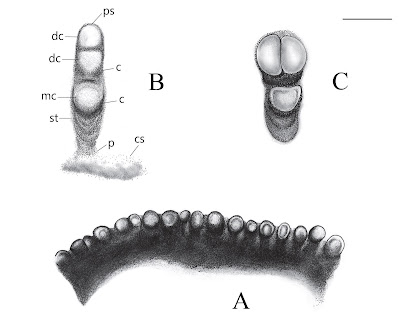Conifers of the genus Glenrosa were first recorded from the
Early Cretaceous Glen Rosa Formation of Texas in 1984 (although specimens of
the plant had been collected in the area since the 1890s), and subsequently
recorded from widely distributed Early Cretaceous from North America, Europe
and Asia, suggesting that for a while it was a widespread and dominant plant in
the Northern Hemisphere. Glenrosa is
distinguished by having small fleshy triangular leaves held close to the stems,
with stomata (breathing pores) grouped together in deep stomatal crypts
(indentations on the leaves). Such crypts are known only from a single other
species of Conifer, Sedites rabenhorstii,
which also lived in the Cretaceous, making interpretation of its ecological
significance difficult, however similar structures are found in some modern
Angiosperms (flowering plants), the majority of which live in arid climates,
suggesting that the pores may help to regulate water loss in dry conditions.
In a paper published in the
journal PLoS One on 19 August 2015, Jean-David Moreau of Géosciences Rennes at
Université Rennes and the European Synchrotron Radiation Facility, Didier Néraudeau, also of of Géosciences Rennes at Université Rennes, Paul Tafforeau also of the European Synchrotron Radiation Facility and Éric Dépré of the
Groupement d’Etude et de Contrôle des Variétés et Semences, describe a new
species of Glenrosa from material
included in flint nodules collected from Early Cretaceous deposits at
Font-de-Benon Quarry, between the villages of Archingeay and Les Nouillers in
the Charente-Maritime Department of western France.
The new species is named Glenrosa
carentonensis, meaning ‘from Charente’ (Carentonia is the Latin name for
the River Charente). The species is described from a number of specimens of
fragmentary material up to 50 mm in length preserved in flint nodules. Since it
is essentially impossible to extract plant remains from hard flint, the
specimens were examined using propagation phase-contrast X-ray synchrotron
microtomography at the European Synchrotron Radiation Facility.
Plant fossils embedded inside flint nodules. (A) Broken flint nodule with
diverse conifer inclusions, SIL_ARC_2. (B) Leafy twigs of Glenrosa carentonensis. (C) Leafy twigs of Glenrosa carentonensis. (D) Leafy axis of Glenrosa carentonensis bearing distally a microsporangiate cone on
its distal tip. (E) Detail of the same cone. Moreau et al. (2015).
The leaves of Glenrosa carentonensis are arranged
helically around the stems; they are flesh and somewhat claw-shaped, with a
waxy cuticle and numerous stomatal crypts, each containing 7-12 stomata.
Several male cones were found in the sample, the first time these have been
recorded for any species of Glenrosa.
These are 2.8–5.0 mm long and 2.3–4.1 mm wide and bear up to 40 microsporophylls
regularly distributed along the cone axis. Each microsporophyll bears 6-7
pollen sacs in clusters up to 0.5 mm wide. The pollen could be determined to be
17.3–20.3 μm long and 10–16 μm wide, but no details could be discerned.
Propagation phase-contrast X-ray synchrotron microtomograph, virtual
sections of Glenrosa carentonensis reconstructed
using a single distance phase retrieval process. (A) Longitudinal section of
leafy axis. (B) Transversal section of leafy axis. (C) Longitudinal section of
twig and cone. Moreau et al. (2015).
The stomatal crypts, fleshy
leaves and thick waxy cuticles of Glenrosa
carentonensis all appearto be adaptations to an arid climate, while the
inclusion of the material in flint nodules implies a coastal environment (all
flint deposits are thought to have originated in shallow-marine environments).
Moreau et al. suggest the plants were
a major component of a dry coastal Conifer forest, with occasional storm events
and possibly haline influences (salt laden winds).
Propagation phase-contrast X-ray synchrotron microtomograph 3D
renderings of Glenrosa carentonensis.
(A) Helically arranged leafy axis. (B–C) Leafy axes bearing a microsporangiate
male cone. Moreau et al. (2015).
See also…
Amber is the mineralized remnants of resins secreted by ancient plants. It is valued by palaeontologists due to the frequent presence of preserved insects, pollen and soft-bodied micro-organisms within amber clasts; it is also widely used in the jewellery industry, and in Chinese medicine. The resins which form amber...
The Chinese Arborvitae, Platycladus orientalis, is a species of Cypress widely grown as an ornamental plant in China, North...
Diptocarps, Dipterocarpaceae, are the dominant trees of modern South and Southeast Asian rainforests, and are also found in South America, Africa and Madagascar. The group reach their maximum diversity today on the island of Bornea, where there are over 280 described species of Diptocarp, but the earliest fossil Diptocarps...
Follow Sciency Thoughts on
Facebook.
































